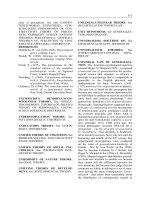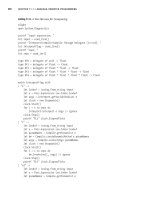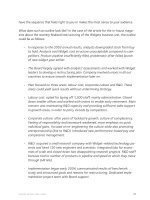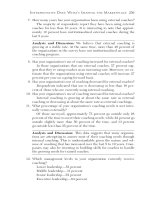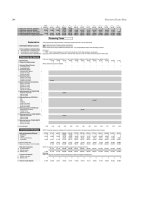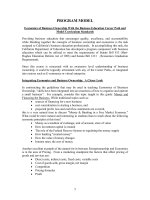Economics of business ownership phần 10 pot
Bạn đang xem bản rút gọn của tài liệu. Xem và tải ngay bản đầy đủ của tài liệu tại đây (173.71 KB, 19 trang )
109
Economic Stabilization-12
Instructional Ideas
3. Give students examples that will drive home this concept.
• Note that the aim of President Bush's tax cut of 2001 was to lower
taxes thereby increasing the amount of spendable income people
have.
• Demonstrate these points with the circular flow.
4. Restrictive fiscal policy aims at economic efficiency by reducing
aggregate demand (some may also slow the growth of aggregate supply).
• Reducing aggregate demand is achieved by taking opposite actions
to expansionary policies–reduce government spending and increase
individual and corporate taxation.
C. Understanding the multiplier effect
1. The multiplier effect is the idea that any change in policy affects total
demand and total income by an amount larger than the amount of the
change in policy.
2. The multiplier effect works with both expansionary and restrictive
policies.
• Allow students to explore this concept by picking out a product
which the government spends heavily on and show its multiplier
effect throughout the various businesses and suppliers.
D. The interaction/trade-off between fiscal policy and unemployment/inflation
1. Fiscal policy can be used for one of three purposes: to affect
unemployment, to deal with inflation, and/or to institute wage and price
controls.
2. To lower unemployment, an expansionary policy is needed (increase
government spending or lower taxes).
• Technical terms: an increase in aggregate demand will lower
demand deficiency unemployment.
• Questions to consider: how can government affect unemployment in
the auto industry by spending more? How will the impact get to the
auto workers?
3. Fighting inflation demands restrictive fiscal policies (cutting government
spending and raising the level of taxes).
• Technical terms: price level is reduced by reducing aggregate
demand.
110
Economic Stabilization-12
Instructional Ideas
4. Help students distinguish between demand-pull forces and cost-push
forces in the inflation arena.
• Policies described above (restrictive policies) will only affect the
demand side of the market.
• If cost-push is driving inflation, other policies are needed–better anti-
trust laws, or as some economists suggest, wage and price controls
(to be discussed in the last section of this unit).
5. Discuss trade-offs within fiscal policy decisions.
• An expansionary policy may reduce unemployment but increase
inflation.
• A restrictive policy may reduce inflation but increase the
unemployment rate.
E. The national debt and the economy.
1. The national debt is the amount of money that the government owes-to
Americans who hold savings bonds, to investors who purchase
government paper, and to individual governments outside the U.S. who
purchase government bonds at monthly auctions.
2. Explain "why" the government borrows and the positive and negative
side to borrowing.
3. Note with students that national debt is not an economic problem, but a
political problem. It is politicians (spurred on by their ever-demanding
constituents) who have not considered carefully the need to balance the
costs and benefits of spending programs they pass into legislation.
4. The trend for U.S. debt is constantly up 2001 put at 5.7 trillion, or
$20,000 per person in the U.S.
5. The national debt has increased by 182 million dollars a day since 1998.
12-03 Wage and Price Controls
A. The use of wage and price controls
1. Wage and price controls are sometimes called "incomes policy" because
they seek to control individual's income and buying power.
2. Wage and price controls are sometimes used to handle cost-push
inflation where fiscal and monetary policies are not particularly
successful.
3. These controls were used extensively during World War II.
111
Economic Stabilization-12
Instructional Ideas
• Explain to students how prices send a signal to business and the
interruption in this signal caused by wage and price controls.
• Relate the shortages that occurred during World War II and ask:
"Why did this happen?" “How did rationing affect the pricing
signal?"
B. The relationship between wage and price controls to subsidies, minimum wage,
and floors/ceilings
1. Help students to see that these three categories are a form of wage and
price control, but are not of the type instituted by former President
Nixon.
2. Briefly review these categories as they have been covered in more depth
in previous chapters.
C. The pitfalls of wage and price controls.
1. Summary: wage and price controls generally do not work well because
they cause price signals to fail, leading to an imbalance between supply
and demand.
2. In fairness, however, wage and price controls have not been tried
successfully over a long period of time (in peacetime) or with specialized
targets (large labor unions or certain concentrated businesses).
3. Most economists do not favor wage and price controls. Ask: "Why is this
the case?” “ What is there about wage and price controls that bothers
economists?"
112
Role of Government-13
Standard and Benchmarks
Role of Government-13
STANDARD AND BENCHMARKS
Standard
Benchmarks
13-01 Market Failure
• Define how the market system fails from time to time.
• List the three terms used to define market failure, spillovers, third party effects
and negative externalities.
• State what happens when market failure occurs.
• Explain the role of government in correcting market failure.
• List three examples of market failure.
13-02 Public Goods and Services
• Define the public sector.
• List public goods and services corporately owned and shared by all members of
the economy.
• Explain the dependence of the private sector on the public sector to operate
efficiently.
• Describe externalities and their relationship to the market system.
13-03 Income Distribution
• Describe how income is derived from production.
• Explain the traditional manufacturing orientation of the U.S. economy and list
the future possible base(s) for U.S. economy.
• Describe the personal income distribution system within U.S. society.
• Explain the causes of poverty and the relationship of income distribution.
13-00 Students will understand the role of Government as a producer of public
goods and services, a regulator of the economy, in maintaining law and
order and the requirements of business to comply with government
regulations. Students will demonstrate competence by identifying the
advantages and disadvantages of government economic intervention and
tax policy from a business perspective.
113
Role of Government-13
Standard and Benchmarks
13-04 Tax Policy
• List the five purposes of taxation.
• Explain the uses of revenues collected through taxation.
• State the two sides of taxation principles.
13-05 Government Rules and Regulations
• Explain the importance of government rules and regulations for the aspiring
entrepreneur.
• Relate specific government regulations to individual businesses.
13-06 Regulating the Economy
• Describe the six ways the government regulates the economy.
• Explain the referee role government plays in encouraging competition.
• Describe the government's role in establishing law and order in the economy.
13-07 Business Record Keeping
• List five reasons for keeping records in a business.
• Distinguish between single or double entry bookkeeping and determine which
one is best for varying kinds of businesses.
• Identity all of the accounting records required in bookkeeping.
• Reconcile a bank statement that includes six different types of transactions.
• Compute employee wages and deduction problems.
• Explain the procedures involved in documenting each transaction.
• Describe how to determine a wage rate for employees.
• Define minimum wage laws.
• Explain the origin of minimum wage laws.
114
Role of Government-13
Instructional Ideas
INSTRUCTIONAL IDEAS
General Information
While the pricing system handles the problem of resources allocation and the forces of
supply and demand (acting through the pricing system) substantially impact the three
questions all economies must answer, the reality is that the world of economics is not
restricted to the private market world alone. In this unit we will examine the role that one
of the non-market forces plays in the market. That force is the U.S. government. We
will begin by looking at the role the government plays in cases of market failure,
followed by a wider sweep of the role of the government as a producer of public goods
and services. Then governmental tax policy will be examined along with the role of
government in establishing rules and regulations regulating the economy. And
establishing law and order. Finally, this unit will conclude with a practical look at how
record keeping in a business organization assists in meeting government rules and
regulations.
Benchmark Specific Instructional Ideas
13-01 Market Failure in the Economy
A. How the market system sometimes fails.
1. Marketing involves a mutually satisfying exchange relationship-the
purchaser is happy with the value of the product purchased, and the seller
is pleased with monies received.
• In the correct marketing transaction all the benefits go only to those
involved in a market transaction.
• Remember, we are speaking of a national economic scene: translate
thinking to the national arena.
B. How market failure occurs
1. Spillovers, third party effects, and/or negative externalities are used to
describe market failure.
• Spillovers–consider this familiar California story.
• A major chemical manufacturer dumps waste water containing
chemical impurities into the Los Angeles Bay area. As a result
commercial fishermen must go further and further into the ocean to
catch their daily supply. In addition, harbor recreational activities are
stifled. Subsequently, the California Legislature determines that a
115
Role of Government-13
Instructional Ideas
clean-up of the bay area is needed and 100 million dollars is
allocated for the clean-up.
• Now the question is: "Who were the third party externalities
to
whom the cost of producing chemicals was shifted?"
• This is an example of a "spillover" and a negative third party
externality. Third parties, external to the company, were negatively
affected by the spillover.
• Why did this happen? Because the market system failed.
• Third party–outlined above.
• Negative externalities–outlined above.
C. What happens when market failure occurs
1. The true costs of producing a product or services are not contained solely
with the marketing transaction.
2. The supply and demand curve is affected.
D. Role of government in correcting market failure.
1. Laws
2. Taxes
E. List three examples of market failures
1. Air pollution
2. Water pollution
3. Natural monopolies
13-02 Role of the U.S. Government in the Market Economy as a Provider of Public
Goods
A. Define public sector
1. Public sector is that part of the economy owned by all the citizens and
operated for the benefit of the society by public servants (the
government).
B. Public goods and services corporately owned and shared by all
1. Railways
2. Highways
3. Parks
116
Role of Government-13
Instructional Ideas
4. Schools/universities
5. Rivers and harbors
6. Dams
7. Others
C. Dependence of private sector on public sector operates efficiently by:
1. Promoting competition
2. Defining and enforcing property rights
3. Providing public goods (discussed in "B")
D. Externalities and the market system
1. Externalities are those costs or benefits passed on outside of the market
system.
2. Government deals with externalities through regulation, etc.
3. Ask students to relate marginalism to the cost associated with cleaning
up a chemical spill problem.
13-03 Income Distribution in the U.S. Economy
Note: There are several ways to explain this concept to students. This
section does it in a fourfold way. First, the foundation is laid that production
is central to all our economic efforts, and in the income distribution area this
is certainly true. Our productive capability affects our income and certainly
our distribution efforts. Second, the economy itself is distributed a certain
way in its productive capability and is changing to reflect new economic
realities. Third, personal income in the U.S. is distributed in such a way that
there are pockets or problems requiring some amount of redistribution.
Finally, after looking at the way the U.S. government distributes income to
alleviate inequality, a closer examination is made of poverty.
A. Income is derived from production
1. This key concept deserves reinforcing at this point.
• Stress that as productivity increases, personal, corporate, and
national income rises.
B. The distribution of income by industry
117
Role of Government-13
Instructional Ideas
1. The U. S. economy has traditionally been a manufacturing–oriented
economy with a high percentage of income being earned there.
2. This manufacturing orientation has been changing:
• 1960–33% of the national income came from manufacturing
• 1980–25% of the national income came from manufacturing
• 2000–21% of the national income came from manufacturing
3. What are the possible future bases for the U.S. economy?
• Utilities
• Services
• Communications
• Electronics
C. Personal distribution of income
1. Graphically depict family income distribution in the U.S. in 2001.
2. Inequality in income is best described by using the Lorenz Curve of
income distribution.
• Show the Lorenz Curve over time for students.
D. Income distribution and poverty
1. The definition of poverty is related to "poverty lines" calculated by the
U.S. government (USDA).
• To figure "poverty line". The USDA
• Figures the cost of a nutritious low-cost diet
• Multiplies this figure times three (three is used because the poor
spend about 1/3 of their income on food)
• The poverty line allows for different circumstances–i.e., the figure is
different for a farm family of four.
• The poverty line changes each year at the following figures indicates
for a family of four:
−1970 poverty line level was $3,368
−1975 poverty line level was $5,500
−1978 poverty line level was $6,662
−1979 poverty line level was $7,412
−1985 poverty line level was $12,600
−1999 poverty line level was $16,700
−2002 poverty line level was $18,100
118
Role of Government-13
Instructional Ideas
2. The causes of poverty include:
• Unemployment
• Low productivity
• Problems in the economy
• Unskilled workers
3. Governmental programs attempt to combat poverty
• Negative income tax., earned income tax credits.
• Specific poverty programs (SPA, EOA of 1964, Job Corps,
CETA/JPTA, MEDICAID, MEDICARE, AFDC, and Food Stamps,
rent subsidies, hiring preferences).
13-04 Tax Policy in the U.S. Economy
A. Why do taxes exist?
1. The five purposes of taxation are:
• To stabilize the economy.
• To change consumption decisions.
• To redistribute income.
• To support government activities.
• To correct market failure problems.
B. Where does revenue from taxes go?
1. Seven areas are typically identified for the uses of taxation revenue:
• Income security
• National defense
• Interest
• Health
• Veterans benefits
• Education and employment
• Other
C. The two sides of taxation principles
1. Benefit principle
• Those who benefit pay taxes.
2. Ability to pay principle.
• Those who can best afford to pay, pay most (of the taxes).
119
Role of Government-13
Instructional Ideas
3. Additional discussion should center on the three forms of taxation:
• Progressive taxes–larger % of higher incomes and lower % of lower
incomes.
• Regressive taxes–opposite of progressive taxation.
• Proportional taxes–same % of taxation from all taxpayers.
13-05 Government Rules and Regulations
A. Importance of government rules and regulations
1. Many important questions need to be answered before beginning a
business:
• What kind of taxes will I pay?
• How do laws governing fair competition affect me?
• What kind of license do I need?
• How do I report quarterly earnings?
2. Each of these questions involves regulations.
B. Specific government regulations related to business owners
1. Protection of competition
• The Sherman Antitrust Act
• The Clayton Act
• The Robinson-Patman Act
2. Protection of employees
• The Equal Employment Opportunity Act
• Fair Labor Standards Act
• Occupational health and Safety Act
• National Labor Relations Act
3. Protection of consumers
• Food, drug and cosmetic act
• The Wheeler Act
• Fair Packaging and labeling Act
• Truth-in-Lending Act
4. Protection of the environment
• Environmental Protection Agency
• State and local regulations
120
Role of Government-13
Instructional Ideas
5. Licenses and permits
• State mandated by type of businesses
6. Taxation
• Social Security
• Federal withholding
• Corporate income tax
• State income tax
• Property tax
• Sales and unemployment tax
• Medicare
13-06 Role of the Government in Regulating the Economy and Establishing Law and
order
A. Government regulation of the economy occurs through:
1. Fiscal and monetary policies
2. Price controls
3. Production of certain goods and services
4. Expenditures
5. Regulating the national debt
• Note: 1,2, and 5 were covered as stabilization policies in Unit XII,
connect this section to previous units for students.
B. Referee role of government in promoting competition
C. Government's role in establishing law and order
D. Redistributive role of government
1. See previous section (13-03, A, 1) on five purposes of taxation and the
fairness issue.
2. Note: other points of government role were covered in other units,
including wage and price controls.
121
Role of Government-13
Instructional Ideas
13-07 Record Keeping in the Business Enterprise
A. Why are records kept in business?
1. Records are required for tax purposes (relate to discussion above).
B. Distinguish between single entry and double entry bookkeeping
C. Records included in the record keeping function
1. There are five common accounting records that must be maintained:
• The business checkbook
• Daily sales cash summary
• Accounts receivable
• Bank reconciliation statement
• Basic payroll records
2. Suggested teaching strategy:
• Bring samples of each of the forms used for each area of
bookkeeping to class. Assign students activities to perform in each
area.
• Teach students to reconcile a personal checkbook and then translate
to a business.
• Have students visit a local business and see which forms are used for
bookkeeping.
D. Reconcile bank statement
1. See discussion in 13-06, C, 1 and 2.
E. Compute employee wages and deductions
1. Bring a payroll form to class and have students fill it out with the
appropriate percentages deducted.
F. Procedures involved in documenting wage statements
1. Quarterly tax reports go to federal government.
2. IRS booklet is available explaining each area.
G. How much should employees be paid?
1. Three guiding principles are:
122
Role of Government-13
Instructional Ideas
A person's time and skill are sold in the labor market.
• When demand for labor (amount of labor the business owner would
hire at each wage rate) equals the supply of labor (amount of labor
available at each wage rate) this labor market is in balance.
• The successful business owner must constantly watch these two
factors when determining wage rates.
H. Minimum wage rates and laws
1. An employer is required to pay at least minimum wage for any working
employee due to the Minimum Wage Law passed in 1951.
2. What happens to the demand curve when Minimum Wage Laws are
followed?
I. Origin of Minimum Wage laws
1. Reason given in 1951 and maintained since then: to provide law income
families with a higher income.
Additional Resources:
FBLA
Economics Introduction to Business
/>
Government Awareness Project
/>
123
Education and the Growth of the American Economy-14
Standard and Benchmarks
Education and the Growth of the American
Economy-14
STANDARD AND BENCHMARKS
Standard
Benchmarks
14-01 Territorial Expansion
• Discuss the role of territorial expansion in American economic growth.
• Relate the significant impact of territorial expansion on land, capitol, and
labor.
14-02
Invention and Technology
• Discuss major innovations that have propelled the growth of the American
economy.
• List major inventions that have fueled economic growth in the U.S.
• List technologies that are presently fueling economic growth in the U.S.
14-03 Capitol Stock
• Define capital stock.
• State the role of capital stock in economic growth.
• Relate the importance of capital stock to economic growth.
14-04
Workforce Development
• Explain why education is an important part of the individual, corporate, and
societal economic growth.
• State the way in which education will effect future training needs.
14-05
Incentives and Productivity
• Identity issues of incentives and productivity.
• State the way incentives increase productivity.
14-00 Students will understand the unique role they can play in the growth of the
economy as business owners. They will demonstrate competence by identifying
four factors that have, historically, contributed to American's economic growth.
124
Education and the Growth of the American Economy-14
Standard and Benchmarks
INSTRUCTIONAL IDEAS
General Information
No one can objectively analyze the American economy without acknowledging the
tremendous growth of the American economy. The growth has been uneven at times,
operated in cycles frequently, and had massive failures as in the Great Depression.
However, the economy has demonstrated unusual resiliency and vitality while springing
back from what appeared at times insurmountable setbacks.
In this final unit, we will invite students to observe the growth of the economy and the
way individual and corporate society have been affected as a result of the resiliency of
the economy. The method chosen to demonstrate the growth of the economy is first, to
look at the role of territorial expansion as a propelling force in the discovery of new lands
and natural resources. Second, a brief overview of the way that innovations, inventions,
and technological improvements have impacted economic growth ill be covered. Third,
the nation's increase in capital stock will be discussed as contributory force in economic
growth. Finally, the role that education has played in training and mobilizing our nation
will be highlighted as a key factor affecting economic growth.
This unit is an excellent opportunity once again to challenge students about the unique
role they can play in the economy as business owners–their privilege and responsibilities
to contribute to our nations economic growth and in the process improve their own lives.
Benchmark Specific Instructional Ideas
14-01 Role of Territorial Expansion
A. Discuss the role of territorial expansion in American Economic Growth
1. Review what territorial expansion involved–job students' memories from
courses in history.
2. Remind students of the way that early American settlers were intent on
improving their economic lot.
B. Significance of territorial expansion on land, labor, and capital
1. Review each area for significance to economic growth.
14-02 Innovations, inventions, and technologies
125
Education and the Growth of the American Economy-14
Standard and Benchmarks
A. Two major innovations of the American economy
1. Assign students the task of researching two innovations and bringing the
results back to class.
B. Two major inventions impacting the American economy
1. See A, 1 above.
C. Two major technologies affecting the American economy
1. See A, 1 above.
14-03 Capital Stock
A. Define capital stock
B. Role of capital stock in economic growth
C. Importance of capital stock to economic growth
14-04 Education in the growth of the economy
A. Importance to individual, corporate, and societal growth
B. Education and future training needs
1. Cover the typical education required in the emerging technologies:
communications, electronics, and telecommunications.
2. Hudson Institute indicates that $150 billion is spend on private training
of employees.
3. The issue of education's role and impact in meeting society's training
needs is an important one.
• Ask: "Does productivity apply to education?"
• Ask: "Why do better educated people produce more?"
4. Use the Lorenz curve to raise the issue of income equality and discuss
within the context of training functions of education.
14-05 Incentives and Productivity
A. Economic growth is achieved in one or more the following ways:
126
Education and the Growth of the American Economy-14
Standard and Benchmarks
An increase (discovery) in the quality and quantity of a nation's resources
1. An increase in the quantity and quality of labor and capital
2. An increase in the nation's rate of technological progress
3. The industriousness and willingness of people to be productive
B. Note that 2, 3, and particularly 4 are directly related to incentives–a willingness of
people to work hard for distinct reward.
1. Clearly incentives increase productivity.
2. Ask: "Why do people work harder when an incentive is involved?"
3. Relate their answers to the macro level.
Additional Resources:
FBLA
American Enterprise Project
www.cafbla.org/dox/cap/american_enterprise_project.pdf
127
Education and the Growth of the American Economy-14
Standard and Benchmarks
References
1.
Stigler, G. L. “Elementary Economic Education,” American Economic Review,
53 (May 1963) 653-659.
2.
Stigler, G. L. “The Case If Any, For Economic Education,” Journal of Economic
Education, Spring, 1970, 77-84.
3.
Drucker, Peter F. Innovation and Entrepreneurship Practices and Principles,
N.Y., N.Y.,: Harper and Row, 1985.
4.
Naisbitt, John. Megatrends. N.Y.: Warner Books, 1987.
5.
Parsons, Edgar. From an address at the American Vocational Association, 1984.
6.
Warmke, Palmer & Nolan, Marketing in Action, McGraw-Hill Book Company,
New York, N.Y.: 1983, p. 10.
7.
Bach, G. L. & P. Saunders. “Economic Education: Aspirations &
Achievements,” American Economic Review
, 55 (June 1965), 329-356.
8.
Bach, G. L. & P. Saunders. “Lasting Effects of Economic Courses at Different
Types of Institutions,” American Economic Review,
56 , (June 1966), 505-511.
9.
Saunders, P. “The Lasting Effects of Introductory Economics Courses,” Journal
of Economic Education, 12:1 (Winter 1980), 1-14.
10.
Kourilsky, Marilyn. “Economics Reasoning and Decision Making by High
School Students: An Empirical Investigation.” The Social Studies
, (March/April
1985), 69-75.

